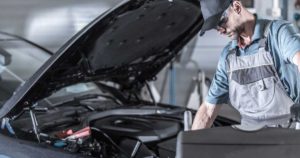The auto industry is changing fast. Today, 90% of car buyers start their search online. That’s right, 9 out of 10 potential customers turn to the internet before they step into a showroom. If your car dealership isn’t showing up on those searches, you’re missing out. Big time.
Online presence isn’t a luxury anymore; it’s a necessity. Your competitors know this. They’re online. They’re optimizing. They’re capturing that digital audience. So, where does that leave you?
SEO isn’t just about search engines. It’s about people. Good SEO places your dealership in front of those who are actively looking for what you offer. It drives digital footfall. And guess what? It converts that online interest into offline visits.
If you want a piece of the online pie, you need to understand SEO. More importantly, you need to implement it. SEO can, and will, transform your car dealership’s digital visibility. Let’s dive in and shift gears into the digital age.
Why Car Dealerships Need SEO Now More Than Ever
1. Shift in Consumer Behavior:

Here’s a fact that might surprise you: 90% of consumers now start their car-buying process online. Think about that. Gone are the days when people wandered from one dealership to another. Now, they have their smartphones. They have their laptops. They start their research online. Before they even step into your showroom, they’ve likely visited your website, read reviews, and compared your offerings with others.
2. Competing in a Saturated Market:

The auto industry is crowded. Everyone is vying for attention. You’ve got massive dealerships with huge marketing budgets. Then there are the small, local dealerships trying to get a slice of the pie. How do you stand out? How do you get noticed? Without SEO, you’re like a needle in a haystack. But with a strategic SEO approach, you can rise above the noise. It’s not just about competing; it’s about dominating.
Capturing Local Clientele: The Significance of Local Searches:
Do you know that 46% of all Google searches are local? Let that sink in. People aren’t just looking for any car dealership; they’re looking for your car dealership in your city. “Car dealerships near me”, “Best car showroom in [City Name]”. These are the types of searches people make. If your dealership isn’t optimized for local search, you’re leaving money on the table. Big money. Local SEO isn’t a choice; it’s a must-have.
In a nutshell, the landscape has changed. Car buyers are online. They’re local. They’re discerning. If you’re not leveraging SEO, you’re missing out on a massive opportunity. Remember, it’s not about getting traffic. It’s about getting the right traffic. And for that, SEO is your best bet. Don’t get left in the digital dust.
On-Page SEO for Car Dealerships
1. Keyword Research Specific to Auto Dealers:

Keyword research isn’t just about high search volume; it’s about relevance. When it comes to car dealerships, specificity is king. Are you dealing in specific car brands? Models? Services? If so, these terms need to be on your radar.
For instance, if you’re a dealer specializing in electric vehicles, terms like “Tesla Model 3 in [City Name]” or “best electric SUVs near me” are gold. Then there are local terms. Think “Ford dealership in [Your City]” or “car servicing in [Your Neighborhood]”. Remember, it’s about meeting the searcher where they’re at.
2. Meta Descriptions, Titles, and Headers:

Meta descriptions and titles are your first impressions on search engines. They need to be crisp. They need to be compelling. More importantly, they need to be relevant. Here’s a pro tip: include primary keywords in your titles and meta descriptions.
If you’re selling Toyota Camrys in Boston, a title like “Buy Toyota Camry in Boston | [Your Dealership Name]” is far more powerful than a generic “Buy Cars Online”. And don’t forget your headers. They should guide the reader, emphasize main points, and yes, include those targeted keywords.
3. Content Creation: Writing for Potential Car Buyers and Service Seekers:

Content is king. But not just any content – valuable content. Think about the questions your potential customers might have. “What are the best cars for families?” “How often should I service my car?” “What’s the difference between sedan and SUV?” Your content should answer these. Create blog posts, articles, videos, and infographics that address these questions. Keep the tone conversational. Engage the reader. Offer value. And always, always keep the user intent in mind.
The bottom line? On-page SEO isn’t about tricking search engines. It’s about providing real value to real people – your potential customers. Understand them, cater to them, and the rankings will follow. Your showroom won’t just be full of cars, but bustling with informed customers ready to make a purchase.
Technical SEO Essentials for Car Dealerships
1. Mobile Optimization: Catering to On-the-Go Searchers:

Here’s a stat to consider: Over 50% of all online traffic now comes from mobile devices. What does this mean for your car dealership? Simple. If your website isn’t mobile-friendly, you’re losing out. People search for cars while waiting for their coffee, during lunch breaks, even while watching TV. If your site doesn’t load properly on their devices, they’ll move on. Ensure that your website is responsive. Make sure buttons are easily clickable, images load correctly, and information is easily accessible. Mobile optimization isn’t a choice; it’s a must.
2. Website Speed: Importance in User Experience and Bounce Rate:

Speed matters. Every second counts. Research indicates that a mere two-second delay in website load time can increase bounce rates by up to 50%. That’s potential customers, gone in a flash, literally. Tools like Google PageSpeed Insights can give insights into what’s slowing your site down. Compress images, minimize code, use a content delivery network (CDN). Do whatever it takes to shave off those extra load-time seconds. A faster site doesn’t just please search engines; it delights users.
3. Structured Data for Car Inventory: Helping Search Engines Understand Your Offerings:

Search engines are smart, but they’re not mind readers. That’s where structured data comes in. By using structured data, you can clearly communicate details about your car inventory to search engines. Details like car model, year, price, and more. This ensures when someone searches, say, for a “2023 Honda Civic with sunroof,” your relevant inventory pops up if you have it in stock. Structured data acts like a translator between your website and search engines, ensuring they understand the specifics of your offerings.
In the realm of SEO, technicalities can’t be ignored. While on-page efforts make your site appealing to users, technical SEO ensures it’s loved by search engines. It’s like the engine under the hood of your car; not always visible, but crucial for performance. Fine-tune it, and watch your digital showroom thrive.
Off-Page SEO Strategies for Car Dealerships
1. Building Quality Backlinks

Backlinks are the lifeblood of off-page SEO. Think of them as votes of confidence from other websites. But not all votes are created equal. Quality matters. Collaborate with car reviewers who can vouch for the vehicles you’re selling. Partner with local businesses for cross-promotions.
Maybe there’s a local cafe where you can host a car-themed event. Reach out to auto industry influencers, get them to test drive a car, or attend a launch event at your dealership. These high-quality, relevant backlinks not only boost your site’s authority but also drive targeted traffic.
2. Managing Online Reviews

Did you know that 88% of consumers trust online reviews as much as personal recommendations? Your online reputation can make or break your dealership. Platforms like Google My Business and Yelp are essential. But don’t stop there. Niche auto review platforms can be goldmines. Encourage satisfied customers to leave positive reviews.
Address negative reviews professionally, showing potential customers you value feedback and are committed to continuous improvement. Reviews not only influence consumers but also send trust signals to search engines.
3. Social Signals: Engaging Potential Clients Through Social Media Platforms

While the direct SEO impact of social signals (likes, shares, comments) is still a topic of debate, there’s no denying their value in driving traffic and building brand awareness. A vibrant, engaging social media presence can act as a beacon for potential clients. Share behind-the-scenes looks at your dealership.
Highlight customer testimonials. Showcase new arrivals or special promotions. Engage in local community events and highlight them on your platforms. Social media isn’t just about broadcasting; it’s about engaging, conversing, and building relationships.
Off-page SEO isn’t just about ranking higher on search results; it’s about building a formidable online presence. It’s about becoming the go-to dealership in your region, not just in search results, but in minds and conversations. Invest in these strategies, and you won’t just see an increase in digital traffic, but in real footfall, loyal customers, and thriving sales.
Local SEO: Capturing Your Immediate Market
1. Importance of NAP (Name, Address, Phone Number) Consistency
Imagine heading to a cafe only to find it’s not there. Frustrating, right? That’s exactly how customers feel when your dealership’s NAP details are inconsistent across the web. It’s not just about annoyance; it’s about trust. If your NAP is inconsistent, search engines may lose confidence in displaying your business for local searches. Regularly audit your online presence. Ensure your NAP details are accurate and consistent everywhere – from your website to directory listings.
2. Leveraging Google My Business for Maximum Local Visibility:
Google My Business (GMB) isn’t just another listing; it’s your digital storefront. Over 90% of global search traffic comes through Google, making GMB an absolute must-have. Keep your profile updated. Add high-quality images of your dealership, available cars, and happy customers. Mention special hours, promotions, and events. Regularly post updates. An optimized GMB listing doesn’t just enhance visibility, it gives potential customers a glimpse of what to expect when they walk through your doors.
3. Collecting and Managing Reviews: Building Trust Within the Local Community:
In the digital age, word-of-mouth has transformed into online reviews. For local businesses, especially car dealerships, this is invaluable. Positive reviews can significantly uplift your dealership’s reputation. Actively encourage satisfied customers to leave feedback. Celebrate and highlight positive reviews. More importantly, address negative ones. Show the community that you care, that you value their opinion, and that you’re always striving to improve. These reviews not only establish trust but signal to search engines that you’re a reputable, trustworthy local business.
Local SEO is about more than just being found; it’s about being chosen. When potential customers search for car dealerships near them, you don’t just want to appear; you want to stand out as the obvious, trusted choice. By focusing on these pillars of local SEO, you not only drive local digital traffic but solidify your position as a cornerstone of the community.
Content Strategies Tailored for Car Dealerships
Blog Topics

- Your dealership’s blog is more than just a collection of posts; it’s a valuable resource for your potential customers. Here’s how to leverage it:
- New Car Launches: Every time a new model hits the market, potential buyers are searching for details. Be their go-to source. Cover the car’s specs, unique features, and how it compares to previous models.
- Maintenance Tips: Owners want their cars to last. Provide them with regular tips on upkeep, from basic cleaning hacks to understanding when a car needs servicing.
- Financing Options: The financial aspect of buying a car can be daunting for many. Break down the options available, from loans to leasing, making the process transparent and approachable.
Video Content

Today’s consumers are visual. They want to see, hear, and feel before they buy. Video content can do just that:
- Virtual Showroom Tours: Let potential buyers explore your showroom from the comfort of their homes. Highlight popular models, introduce staff, and showcase the unique selling points of your dealership.
- Car Reviews: People trust reviews. Offer candid, in-depth reviews of the cars you sell. Highlight their strengths and address common concerns.
- Test Drive Experiences: Nothing beats the thrill of a test drive. Capture that experience on video, from the roar of the engine to the smoothness of the ride, giving online viewers a taste of the real thing.
Infographics:

Infographics simplify complex information, making it easily digestible:
- Comparing Car Features: With so many models and options, buyers can get overwhelmed. Design infographics that clearly compare car features, helping them make informed choices.
- Explaining Financing: Finance can be intricate. Break down the jargon with clear, concise graphics, illustrating the process and options available.
- Maintenance Guidelines: A car’s health is paramount. Use infographics to break down maintenance schedules, recommended practices, and essential checks.
The auto industry is rich with content opportunities. By focusing on these strategies, tailored specifically for car dealerships, you’ll not only attract potential buyers but position your dealership as a trusted, authoritative figure in the automotive world. And remember, it’s not just about selling cars; it’s about educating, informing, and engaging your audience at every stage of their journey.
Monitoring and Adapting: SEO Analytics for Car Dealerships
SEO isn’t a set-and-forget strategy. It’s a living, breathing entity that requires constant attention and adaptation. Here’s how car dealerships can stay ahead in the game:
Tools Every Car Dealership Should Use:
- Google Analytics: This free tool offers a goldmine of insights. Track where your visitors are coming from, what pages they’re engaging with, and where they might be dropping off. For a dealership, understanding which cars or services are attracting the most attention can guide inventory and marketing decisions.
- Search Console: Another gem from Google. Understand how your site appears in search, which queries are driving traffic, and identify any site issues that might be hampering performance.
- SEMrush or Ahrefs: These comprehensive SEO tools can provide insights into your backlink profile, keyword rankings, and even competitor performance.
Tracking Key Performance Indicators (KPIs):
- Organic Traffic: This metric shows how many visitors come to your site from unpaid search results. A steady increase indicates your SEO efforts are paying off.
- Local Search Rankings: For a car dealership, local clientele is key. Track how you’re ranking for local search terms like “car dealerships near me” or “[Brand] dealer in [City].”
- Conversion Rates: It’s not just about attracting visitors, but turning them into leads or customers. Monitor how many website visitors are filling out contact forms, booking test drives, or making inquiries.
Continuous Improvement
- Adapting to Changing Algorithms: Search engines, especially Google, frequently update their algorithms. Staying updated on these changes and adapting your strategy accordingly ensures you don’t fall behind.
- Consumer Behaviors: From the rise of electric vehicles to changing preferences based on global events, consumer behaviors aren’t static. Regularly review your analytics to identify new trends and adapt your content and SEO strategy to match.
The digital landscape is ever-evolving. By constantly monitoring, analyzing, and adapting, car dealerships can ensure they stay not just relevant, but top-of-mind for potential buyers. The beauty of SEO is in its adaptability. And in a world where change is the only constant, having an adaptable marketing strategy isn’t just recommended; it’s essential.
Common SEO Pitfalls Car Dealerships Should Avoid
The SEO journey is riddled with potential missteps. While striving for digital prominence, car dealerships must be wary of pitfalls that could derail their efforts. Here are some common mistakes to watch out for:
1. Duplicating Content Across Multiple Listings:
It’s not uncommon for dealerships to post the same vehicle description or promotional content across various online platforms. However, duplicate content can confuse search engines and hinder your site’s ability to rank.
The Fix: Craft unique descriptions and content for each listing. Even if two vehicles have similar features, focus on differentiating aspects. Utilize tools like Copyscape or Siteliner to check for duplicate content.
2. Neglecting Mobile Users:
Many dealerships focus on creating visually appealing sites with detailed graphics. While this might look good on desktop, it can lead to slow loading times and poor user experiences on mobile.
The Fix: Implement a responsive design that adjusts to screen size. Regularly test your website’s mobile performance and ensure that all features, especially CTAs like “Book a Test Drive,” function seamlessly.
3. Ignoring Local SEO or Not Responding to Reviews:
In the race to rank nationally or even globally, some dealerships neglect the goldmine that is local SEO. They might forget to claim local business listings or, worse, ignore negative reviews, which can hurt their reputation.
The Fix: Regularly update and optimize your Google My Business listing. Encourage satisfied customers to leave positive reviews. When faced with negative feedback, address it professionally, showing potential customers that you’re dedicated to improving and valuing their opinions.
SEO is a powerful tool for car dealerships, but like any tool, it must be used correctly. By avoiding these common pitfalls, dealerships can ensure that their SEO strategy drives traffic, builds trust, and ultimately, boosts sales. Remember, it’s not just about avoiding mistakes but about creating a seamless, valuable experience for every potential customer that interacts with your digital presence.
Conclusion
In an era dominated by digital touchpoints, the importance of SEO in car dealership marketing cannot be overstated. It’s no longer just a competitive edge but an essential cornerstone. As modern consumers steer their buying journeys starting from online searches, your dealership’s visibility becomes crucial. Missing out on a strong SEO strategy is akin to letting potential buyers walk past your showroom without even glancing in. In fact, one of our clients saw a staggering 1891% increase in traffic after implementing a comprehensive SEO strategy.“
For dealerships yet to embark on their SEO journey, there’s no better time than now. And for those already in the game, remember, SEO is ever-evolving. Regular reviews and revamps ensure that you’re not just keeping pace with the industry but setting the benchmark.
- Review Your Strategy: If you’re a car dealership, take a moment to analyze your current SEO strategies. Are they driving the results you desire? Are there potential gaps or pitfalls you might be overlooking?
- Feedback & Questions: We understand that the digital terrain can sometimes feel daunting. If you face specific challenges or have questions about any SEO aspects, don’t hesitate to reach out. Sharing insights and finding solutions together will elevate the industry as a whole.
This guide is just the tip of the iceberg. For more detailed insights into every nuance of SEO for car dealerships, make sure to subscribe or regularly check in. The road to SEO success is a journey, and we’re here to guide you every step of the way.
To thriving in the digital age and driving footfalls both online and offline, here’s to your dealership’s success and growth!









